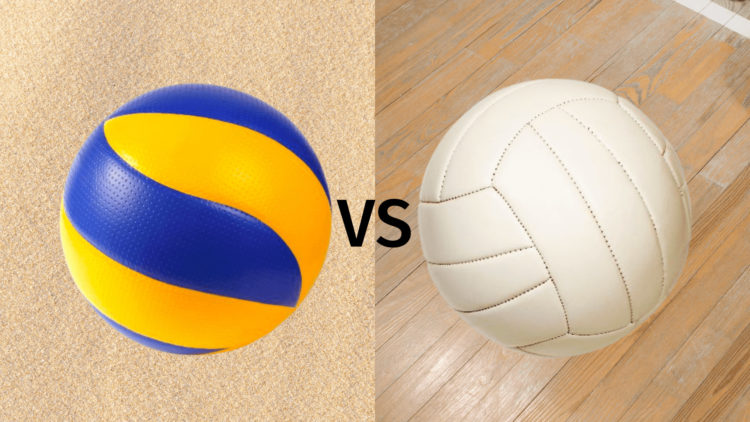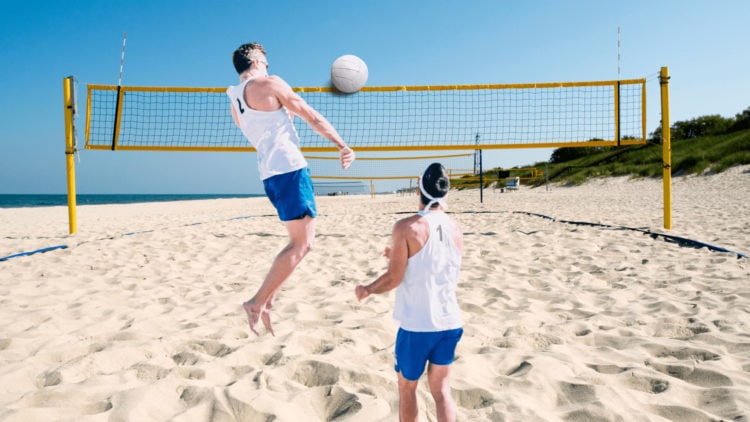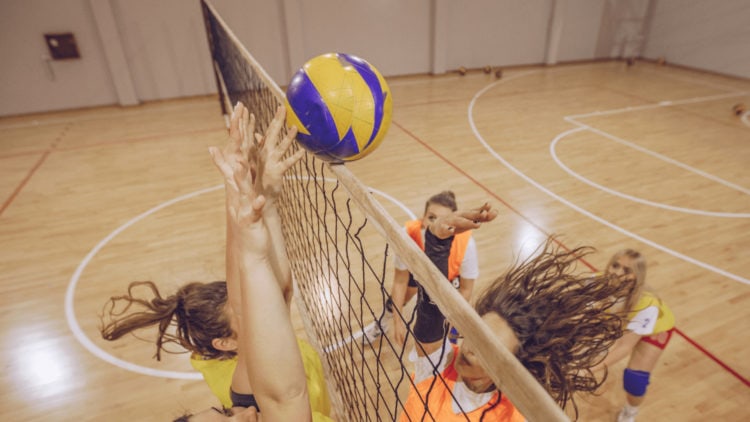
Despite being played on vastly different court surfaces, beach volleyball and indoor volleyball are variations of the same game, with a few key differences separating the two. Regardless of the similarities, however, the two sports drastically vary in pace, complexity, and even skill sets required to play at a high level.
SIMILARITIES
Before addressing the differences between beach and indoor volleyball, it’s important to understand the similarities shared between both sports.
Both of these sports are fundamentally the same game: volleyball. In other words, the rules and objectives of the two sports are identical: using a maximum of three touches, hitting the ball over the net, and hoping the opponent is unable to return it successfully.
If you understand the rules for indoor volleyball, you will likely understand the vast majority of beach volleyball and vice versa. However, there are still a few stark distinctions between the two volleyball variations, although most are fairly intuitive.
DIFFERENCES

Despite the two sports being nearly identical in terms of gameplay, both beach and indoor volleyball look and play quite differently from each other, primarily due to differences in the team and court sizes.
PLAYING SURFACE
The most apparent difference between these two volleyball sports is the surface they’re played on. Indoor courts versus a sand court.
Indoor volleyball, which is considered the traditional volleyball game that most people are familiar with, is played on indoor volleyball courts made of wood or vinyl/PVC. The legal playing surface is 59 feet in length and 29.5 feet in width.
Beach volleyball isn’t required to be played on a beach, although it must be played on sand. In contrast to its indoor alternative, a beach volleyball court is a slightly smaller court measuring 52.6 feet in length and 26.25 feet wide.
EQUIPMENT
- Attire: There are no strict regulations regarding what an athlete should wear in either beach or indoor volleyball. However, a beach volleyball player is required to wear the same attire as their teammate, while indoor players must wear matching jerseys (except for the libero).
- The Net: Both sports are played with a net spanning the entire width of the court. This net must be 7.97 feet tall for men and 7.35 feet high for women.
- The Ball: Both sports feature a round ball comprised mainly of leather, although the specifics of each differ slightly. An indoor volleyball is smaller, heavier, and can move faster than a beach volleyball. Due to being larger and lighter than its indoor counterpart, a beach volleyball is meant to travel slower to allow the players more time to keep it off the ground.
TEAM SIZES, POSITIONS, AND ROTATION
Indoor volleyball teams have six players on the court at once. Each of these players is designated a position:
- Setter: A setter is often the second player to contact the ball during a volley. This position is responsible for accurately “setting” the ball in a gentle manner that allows their teammates to spike it toward the opponent’s side of the net.
- Outside Hitter: This position is the lead attacker in most volleyball sets. Players in this position must be proficient at jumping high, as they’re often responsible for hitting the ball over the net and spiking.
- Opposite Hitter: While also responsible for hitting the ball over the net in many cases, the opposite hitter differs from the outside hitter because they’re usually positioned behind the attack line in the back row. This positioning generally acts as a defensive player receiving the opponent’s serve, not just an offensive player who leads attacks.
- Middle Blocker: Also known as a middle hitter, this position is tasked with blocking the opponent’s attacks right at the net. Due to having this responsibility, the middle blocker is normally the tallest player.
- Libero: The libero is a unique position; they wear a different-color jersey than the rest of their team, are only allowed to play in the back row and cannot attack/spike the ball. The libero is considered a defensive specialist, although they are uniquely allowed to substitute out/in for any player in the back row without that substitution counting toward the team’s 12 substitution limit. The libero is often the team’s most agile and best passer.
- Defensive Specialist: Similar to a libero, this player sticks to the back row and is in charge of receiving serves and spikes from the opponent.
Although every player has a position they excel at, the players must rotate clockwise every time their team is given serving rights. This rotation allows every player on the court to eventually serve if they aren’t substituted out of the game.
Because of this rotation, all players must be proficient in multiple roles. However, every player can still usually preserve their original position’s responsibilities regardless of where they position themselves on the court.
Beach volleyball teams consist of only two players. Due to this tiny team size, neither player is designated a position, as each must be proficient at every aspect of the game and work together to cover the entire court. Despite this, one player often plays closer to the net (to block shots) while the other stays more in the backcourt.
Since there are only two players per team, there is no rotation as there is in indoor volleyball. However, serving responsibilities alternate between beach volleyball players, essentially acting as a rotation.
SUBSTITUTIONS
Indoor volleyball allows each team 12 total substitutions per set. These substitutions are frequently used when players are forced to rotate to a position they struggle at, as they’d otherwise be an easy target for the opponent. As mentioned previously, the libero can substitute in or be substituted out without detracting from a team’s 12-substitution limit.

Beach volleyball has no substitutions at the professional level, meaning the two players on each team must play the entire match. However, at the amateur level, teams are often allowed unlimited substitutions as long as the substitutions do not interfere with the match’s pace.
GAMEPLAY
Beach and indoor volleyball games begin in the same way: one team serves the ball over the net to the opposing team. The receiving team is allowed three total touches the get the ball back over the net, although the same player cannot register consecutive touches.
The back-and-forth volley action continues until one team hits the ball out of bounds, is unable to return it over the net in three touches, or the ball contacts the ground in bounds. The team that wins the rally is given the next serve.
SCORING
In both volleyball sports, a point is scored when a rally ends. A team can score when any of the following occurs:
- The opponent cannot legally return the ball before it contacts the ground, is touched more than three times on their set of the net, or is touched multiple times in a row by a single player.
- The opponent hits the ball out of bounds.
- The opponent commits a foul.
All of these instances result in a team scoring one point.
MATCH STRUCTURE

Indoor volleyball matches are played in a best-of-five format, with the first team to win three sets being the victor.
Each set is played until one team scores 25 points, with a tiebreaking fifth set being played to only 15 points. Similar to other net sports, a team must win by two points, with no cap on how high a match’s score can go. This means a set could theoretically end with a 37-35 score.
Beach volleyball is played with a very similar structure as indoor, although matches are only a best-of-three format, with the first team to win two sets being deemed the winner.
Instead of being played to 25 points, beach volleyball sets are played until one team reaches a score of 21. Similar to its counterpart, a team must win by two points. Additionally, the third tiebreaker match is only played to 15 points.
SIDE CHANGES
Both volleyball sports require teams to switch sides throughout a match. For indoor, this is done after each set. In beach volleyball, teams swap sides of the net after every seven cumulative points are scored between teams.
PACE OF PLAY
Both indoor and beach volleyball require slightly different skill sets because of the court conditions and team sizes.
Indoor volleyball requires players to have extremely fast reaction times, the ability to work efficiently with five other teammates, and the ability to effectively play multiple positions.
Beach volleyball, while requiring many of the same skills as indoor, is played at a different pace due to the slower-moving ball and sand conditions. The sand is a huge influence on gameplay; sand notoriously slows down movement and makes it far more difficult to jump effectively.
By coupling the movement-detracting effects of sand and the fact that beach volleyball teams only include two players, it should be clear how much endurance is required in this sport. Furthermore, substitutions aren’t even allowed in professional beach matches.
While indoor volleyball is a violently fast-paced sport that requires athletes to be on top of their game at all times, beach volleyball focuses more on a marathon-like endurance aspect. This is not to say that beach volleyball isn’t fast-paced, but the sport is fundamentally designed to be slower and requires one to stave off the fatiguing demands of the game.
- 30 GAMES TO PLAY OVER TEXT - April 22, 2024
- 20+ FREE PRINTABLE BABY SHOWER GAMES - April 16, 2024
- 20+ College Party Games for the Best Night Ever! - April 2, 2024